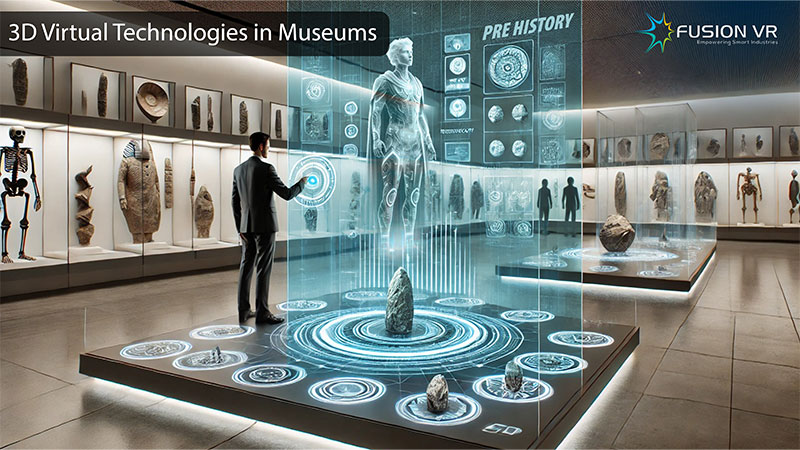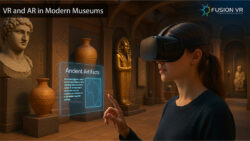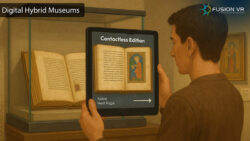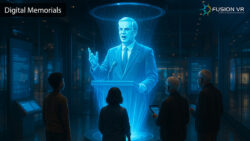The world of museums is undergoing a revolution through the development of 3D technologies. It’s changing the way cultural artifacts, historical exhibits, and art collections are seen and engaged with. It’s an era of interactive experience that takes visitors deep into the heart of stories told behind the exhibits. There comes a time when museums transform from mere depositories to represent living spaces where history, art, and culture reveal themselves in new, almost fantastical dimensions.
The new 3D museum technologies allow visitors to access the previously inaccessible hidden worlds. Imagine walking through ancient ruins, seeing sculptures and paintings from every angle, or even stepping into a recreated version of a historical event. It’s not about how exciting the museums will become. The entire idea is to evolve into a place that delivers something of the past, something of the present, and something of the future – all at the same time. With augmented reality, virtual reality, and cutting-edge 3D visualization, museums are slowly coming forward as places of wonder, awe, and discovery and also as places of rich interrelations with culture.
Such change is headlined by companies like Fusion VR that are focused on specially creating the experience of museum and exhibitions immersion. For this innovative solution, these museums enable an experience well beyond traditional types of exposure where a different involvement of visitor is maintained. Through Fusion VR projects, some of the very latest technologies in 3D are combined in museum projects to allow people to interact, not just look at a piece but really remember that view. The new format of storytelling will help protect history in such a manner that it continues to flow into the audience’s sensibilities.
One of the major factors driving the success of 3D museum technologies is a detailed, high resolution model of artifacts and exhibits. It enables museums to digitize their collections and share them with a global audience through virtual tours and online exhibitions. Modern technologies such as photogrammetry and 3D scanning enable the reproduction even of the smallest details on an incredibly small scale-from elaborate sculptures to sensitive paintings. Digital replicas of those works can be seen and explored anywhere in the world-ever before unthinkable.
The integration of AR and VR further enhances these digital experiences by giving visitors new ways to interact with the exhibits. Augmented reality allows museums to overlay digital content onto physical spaces, creating a blend of the real and virtual that can bring exhibits to life in unexpected ways. This way, for instance, they can point a smartphone camera at a painting and experience how it was done in elaborate detail or walk around an ancient reconstructed city through the AR headset. All of this allows museums to tell a richer, more immersive story that captures their visitor’s imagination.
Virtual reality, however, brings a completely immersive experience. It transports visitors into an entirely new world by giving them a view and sensation of the recreated environment of a prehistoric landscape or a bustling medieval market using a VR headset. This technology creates experiences for museums that are not restricted by physical space and, as such, can have exhibits too large, fragile, or even too distant to be physically shown. Through VR, visitors can experience everything from the inner chambers of a pharaoh’s tomb to the surface of Mars from the comfort of a museum gallery.
These technologies not only enhance visitor experiences but also offer museums useful tools for conservation and research. Detailed 3D models of artifacts created by museums can be used to preserve a digital copy for analysis, restoration, and study. Fragile or deteriorating objects require this kind of detailed study without the risk of physical damage. Further, these digital models can be disseminated to scholars and researchers all over the world in order to encourage cooperation and enhance our knowledge about history and culture.
To embrace these 3D technologies is to give museums the opportunity to reach new audiences. As digital natives become increasingly part of the museum-going public, there is a need for more interactive and engaging experiences. This is precisely what 3D technologies can offer: visually appealing experiences that are also informative and educational. This use of virtual tours and digital exhibitions allows museums to attract people who could never visit them in real life. Even small museums consider it important because this will give them the ability to showcase their collections on an international scale.
Among the best examples of the application of such technologies to create unforgettable experiences is the work that Fusion VR does with museums. Working with museums and other cultural institutions, Fusion VR is helping in the design and implementation of interactive exhibits using 3D technologies that tell stories. The work done in such projects has aspects such as 3D projections, interactive displays, and virtual tours that are created to make visitors feel a sense of immersion and engagement. For example, an historical site virtual tour may contain interactive points that can teach visitors about specific artifacts or a re-enactment of a historical event. Thus, the simple experience of a tour can transform into an educational journey, ensuring history sounds more real for visitors.
So much more innovative and creative applications will now be seen from museums as they continue to explore what 3D technologies have to offer. The possibilities of storytelling and engagement are huge-from holographic displays to multi-sensory installations combining sight, sound, and touch. These technologies can also be integrated into the school curriculum to provide opportunities for schools and families to look at topics like science, history, or art interactively and hands-on. In this regard, this new chapter in the evolution of museums therefore means that technology increases our chance to experience culture but does not supplant it.
The excitement of 3D Virtual museum technologies lies in the idea that the world exists beyond our range of vision. This then revolutionizes the potential offered by museums as transcendents of boundaries transcending time and space. Thus, with immersive technology, it is possible to dive in the depths of the ocean, walk through a Roman villa, or experience cultural festivals from the other end of the globe. Hereby lies the new kind of access which the museum can provide the visitors-through walls, and this method is inclusive and far-reaching.
The 3D museum technology has several other very crucial roles in preserving the culture heritage. Most of the sites and artifacts face the menace of climate change, urban development, and natural decay, hence making digital preservation very crucial for preserving our heritage. In digital preservation, museums make replicas of threatened artifacts and sites to safeguard the treasure in case originals are lost or damaged. This aspect of the 3D technology comes as a means to respect and share cultural heritage in a really modern yet very respectful method.
It’s the future where tradition will combine with innovation into experiences both rooted in the past and forward-looking in the years to come, and here lies the importance of bridging the digital and real worlds, something that allows museums to cherish their status as guardians of the past while embracing modern tools for the digital future. As we probe further into the unseen worlds these technologies reveal, we open a new door to cultural discovery-where every visitor can find his way through the stories that shape our world. From virtual travels through ancient lands to an interactive exhibit that brings history alive, 3D museum technologies are rewriting the way we experience and interact with the tapestry of human culture.





